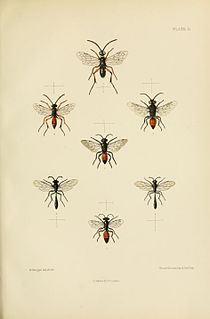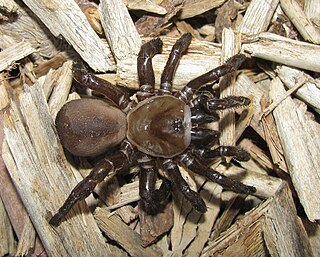
The Mygalomorphae, or mygalomorphs, are an infraorder of spiders. The name is derived from the Greek mygalē, meaning "shrew", plus morphē meaning form or shape. An older name for the group is Orthognatha, derived from the orientation of the fangs which point straight down and do not cross each other. In 1802, Charles Athanase Walckenaer separated mygalomorph spiders into a separate genus, Mygale, leaving all other spiders in Aranea.

Huntsman spiders, members of the family Sparassidae, are known by this name because of their speed and mode of hunting. They are also called giant crab spiders because of their size and appearance. Larger species sometimes are referred to as wood spiders, because of their preference for woody places. In southern Africa the genus Palystes are known as rain spiders or lizard-eating spiders. Commonly they are confused with baboon spiders from the Mygalomorphae infraorder, which are not closely related.

Ctenizidae is a small family of medium-sized mygalomorph spiders that construct burrows with a cork-like trapdoor made of soil, vegetation and silk. They may be called trapdoor spiders, as are similar species, such as those of the families Liphistiidae, Barychelidae, Cyrtaucheniidae and some species in Idiopidae and Nemesiidae. In 2018, the family Halonoproctidae was split off from Ctenizidae, leaving only three genera.

The Pholcidae are a family of araneomorph spiders. The family contains over 1,800 pholcids, including those commonly known as the marbled cellar spider , daddy long-legs spider, granddaddy long-legs spider, carpenter spider, daddy long-legger, vibrating spider, gyrating spider, long daddy, and skull spider. The family, first described by Carl Ludwig Koch in 1850, is divided into 94 genera.

The sac spiders of the family Clubionidae have a very confusing taxonomic history. Once, this family was a large catch-all taxon for a disparate collection of spiders, similar only in that they had eight eyes arranged in two rows and conical anterior spinnerets that touched, and were wandering predators that built silken retreats, or sacs, usually on plant terminals, between leaves, under bark, or under rocks. These are now recognized to include several families, some of which are more closely related to the three-clawed spiders, like lynx and wolf spiders, than to Clubionidae and related families.

The Goliath birdeater belongs to the tarantula family Theraphosidae. Found in northern South America, it is the largest spider in the world by mass – 175 g (6.2 oz) – and body length – up to 13 cm (5.1 in) – but it is second to the giant huntsman spider by leg span. It is also called the Goliath bird-eating spider; the practice of calling theraphosids "bird-eating" derives from an early 18th-century copper engraving by Maria Sibylla Merian that shows one eating a hummingbird. Despite the spider's name, it only rarely preys on birds.

Hexathelidae is a family of mygalomorph spiders. It is one of a number of families and genera of spiders known as funnel-web spiders. In 2018, the family was substantially reduced in size by genera being moved to three separate families: Atracidae, Macrothelidae and Porrhothelidae. Atracidae includes the most venomous species formerly placed in Hexathelidae.

Spider-Man 3 is a 2007 open world action-adventure video game loosely based on the film of the same name and released for Game Boy Advance, Microsoft Windows, Nintendo DS, PlayStation 2, Wii, Xbox 360, and PlayStation 3 on May 4, 2007. A PlayStation Portable version was released on October 17, 2007. The game was delisted and removed from all digital store fronts on January 4, 2017.

Simaetha is a genus of Australasian jumping spiders that was first described by Tamerlan Thorell in 1881. They resemble members of Simaethula and Stertinius.

Cyatholipidae is a family of spiders first described by Eugène Simon in 1894. Most live in moist montane forest, though several species, including Scharffia rossi, live in dry savannah regions. They occur in Africa, including Madagascar, New Zealand and Australia, and one species in Jamaica. Most members of this family hang beneath sheet webs. Fossil species occur in the Eocene aged Bitterfield and Baltic Ambers, suggesting a wider geographic distribution in the past.

Coneweb spiders (Diguetidae) are six-eyed haplogyne spiders that live in tangled space webs, fashioning a cone-like central retreat where they hide and lay eggs. It is a small family, containing only two genera with fifteen species and is confined to the New World, preferring deserts. Members of the genus Diguetia usually build their webs in shrubs or between cactus pads. They have the same eye arrangement as the venomous recluse spiders, but none are known to be harmful to humans.

Ceropales maculata is a kleptoparasitic spider wasp found in the holoarctic region.

Hololena is a genus of North American funnel weavers first described by R. V. Chamberlin & Willis J. Gertsch in 1929.
Wubana is a genus of American sheet weavers that was first described by Ralph Vary Chamberlin in 1919.
Wubana drassoides is a species of sheetweb spider in the family Linyphiidae. It is found in the United States.
Habronattus sabulosus is a species of jumping spider in the family Salticidae. It is found in the southeastern United States.
Wubana pacifica is a species of sheetweb spider in the family Linyphiidae. It is found in the United States.

Agelenopsis emertoni is a species of funnel weaver in the family of spiders known as Agelenidae. It is found in the United States. The spider was named to honour arachnologist James H. Emerton. A. emertoni is distinguished from other Agelenopsis species in the genus by the male's loosely coiling embolus making more than one full circle, and a claw-like conductor tip. These features are sclerites of the male sex organ which is used to inseminate the female. The female has a distinctive conducting tube in her genitalia. The male can be between 6 and 13mm. Distribution is in the following states of the USA: Arkansas, Colorado, Florida, Georgia, Louisiana, Massachusetts, Mississippi, Missouri, New Jersey, New York, North Carolina, Oklahoma, Pennsylvania, Tennessee, Texas, Virginia.

Halonoproctidae is a family of mygalomorph spiders, split off from the family Ctenizidae in 2018. Species in the family are widely distributed in North and Central America, Australasia, Asia, southern Europe and North Africa. One species is recorded from Venezuela in South America. They are relatively large, sombrely coloured spiders, that live in burrows with some kind of trapdoor.














